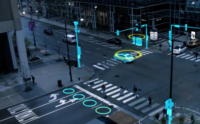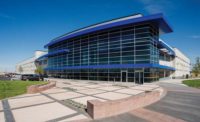Smart Cities: Technology, Integration, Communication and Collaboration

Pena Station NEXT is a transit-oriented development located near 61st & Peña Station along the rail line to Denver International Airport.
Photo courtesy of Pena Station NEXT
By Deborah Schindler, SMPS Colorado Chapter
 The Society for Marketing Professional Services’ Colorado Chapter, with more than 265 members, is one of the top five chapters in the national organization. Deb Schindler has 30-plus years of experience in the industry and has served SMPS in a variety of roles. She can be reached at dschindler@redhoundstudios.com.
The Society for Marketing Professional Services’ Colorado Chapter, with more than 265 members, is one of the top five chapters in the national organization. Deb Schindler has 30-plus years of experience in the industry and has served SMPS in a variety of roles. She can be reached at dschindler@redhoundstudios.com.
Today, communities are taking greater advantage of new technologies to push the development of smart cities. Those range from demand response, near-field communication and wireless charging to intelligent lighting, transportation sensors and integrated transportation, says the Institute of Electrical and Electronics Engineers.
The trend toward smart cities isn’t only about technology; it’s also about integrating systems across agencies, private companies and communities. For example, in cities, distribution centers are often clustered in one area. They usually operate 24/7, with freight-hauling semis accessing nearby highways, traversing local neighborhoods and contributing to congestion.
A partnership between the city and distribution centers could provide travel-time reliability. It could also:
- Provide specific hours for the heaviest freight traffic on roads.
- Provide radio sensors at main intersections and on the trucks themselves that would trigger the lights to change at key intersections when trucks approach, thus reducing idling time, saving travel time and lowering environmental impact.
“We proposed this concept as part of Denver’s submittal to the U.S. Dept. of Transportation’s Smart City Challenge,” said Chris Armstrong, senior transportation systems engineer, Jacobs. “Smart cities are about integrating systems between public and private entities to improve the world we live in.”
Pena Station NEXT
An innovative public-private partnership is creating Pena Station NEXT, a 400-acre, transit-oriented development in northeast Denver. Pena Station NEXT is destined to become America’s next great smart, sustainable, mixed-use community. It is located near 61st & Peña Station along the rail line to Denver International Airport.
In December 2014, Panasonic said it would consolidate operations of Panasonic Enterprise Solutions in Denver, including operations for Panasonic CityNOW. The launch included a collaboration among the city and county of Denver, DIA, LC Fulenwider, Xcel Energy, Panasonic and other major stakeholders.
Pena Station NEXT will include hotels, retail, multifamily, entertainment, health care and office facilities. Smart City solutions will include an innovative solar-plus-storage microgrid and smart LED street lights with video analytics.
Other features will support community safety and parking, offering community Wi-Fi, electric vehicle charging stations and autonomous electric shuttles to the rail station. “The development of Pena Station NEXT leverages lessons learned at Fujisawa Sustainable Smart Town, a Panasonic-led smart and sustainable development located outside of Tokyo,” says George Karayannis, vice president, CityNOW, Panasonic USA. “The community is the world’s first truly human-centric smart and sustainable town.”
Sterling Ranch
Sterling Ranch, a new 3,400-acre sustainable development located southwest of Denver will include nine unique villages radiating outward from a town center and civic gathering place, according to the developer’s website. With a focus on pedestrian-friendly spaces and connectivity, development plans include trails, open space and access to state and regional parks.
The community will incorporate forward-thinking technologies and sustainability through its partners: Siemens, CenturyLink, Mortenson, Lumiere, IBM and the Denver Botanic Gardens.



